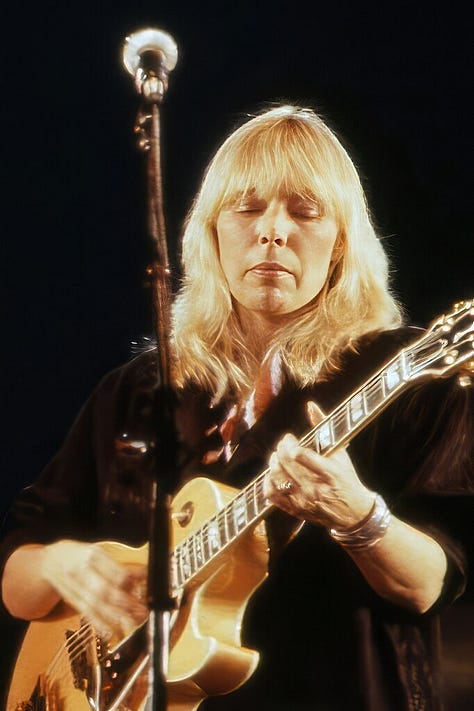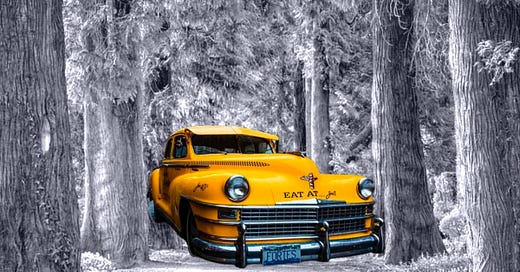Big Yellow Taxi: The Environmental Movement's Anthemic Song
Joni Mitchell set the stage for a generation of activists
Songs were the main “influencers” before the rise of Instagram and YouTube.
We heard songs on the radio.
We bought the album.
We read the liner notes.
And, for good or bad, we all got the same messages.
In the early 1970s, songs streamed out from every speaker. There was not much competition from TV and the Walkman and boomboxes didn’t arrive until around 1979.
It was just radios and record players.
Radios were the mobile phone of the day. Handheld transistor radios in our pockets, under our pillow and even a waterproof version for the shower.
Music surrounded our senses, not unlike video dominates our eyeballs today.
Every week a new album arrived in the record store or a new song blasted on the airwaves.
All of us were in sync with the same sounds and the world presented to us in catchy lyrics and sweet melodies.
It was one big vibe.
The Environmental Movement Starts
I was in my teens during the early 1970s. And I got sucked into movement.
It was not a hard sell.
First, we listened to homages to Mother Earth from a slew of influential artists:
Marvin Gaye, “Mercy Mercy Me (The Ecology)”(1971)
Neil Young, “After the Gold Rush” (1970)
John Prine, “Paradise” (1971)
The Beach Boys, “Don’t Go Near The Water” (1971)
Jackson Browne, “Before the Deluge” (1974)
Second, TV documentaries and mainstream movies warned us all of the dangers of pollution and human impacts:
The Undersea World of Jacques Cousteau, tv series, marine ecosystems (1970s)
Minamata: The Victims and Their World, mercury poison pollution (1971)
Silent Running, movie, deforestation (1972)
Soylent Green, movie, human overpopulation (1973)
Even the Coke commercials tried to play off the global harmony of the the era:
And third, federal legislation kicked in to back the movement with some legal bite.
Whereas, beforehand, environmental problems were left to each state to decide, the 1970s shifted responsibility to the federal government to protect air and water resources:
The Clean Air Act of 1970
The Water Pollution Control Act Amendments of 1972
The 1970 National Environmental Policy Act (NEPA)
the Endangered Species Act of 1973,
The Marine Protection, Research, and Sanctuaries Act of 1972
The Safe Drinking Water Act (1974)
With laws orchestrated to protect wildlife, wilderness and wild rivers and fund pollution research, monitoring and cleanup efforts, the new dawn of environmentalism was ready to rise.
Environmental groups, such as the Sierra Club, were now engaged in national, not just local, issues. And powerful new environmental lobbying organizations hit Washington with a legal punch.
This was the backdrop for the environmental scene in the 1970s.



Pavement Or Paradise
According to the lore, Joni Mitchell was appalled by the contrast of beautiful Hawaiian vistas pockmarked by concrete parking lots. This led her to write “Big Yellow Taxi” as a warning call to protect the environment.
With her angelic voice and simple phrasing, the song, released in 1970, was part of an eco-conscious wave that swept the nation. In 1971, Marvin Gaye, a Motown artist, released “What’s Going On” that promoted ecological awareness to an urban audience.
These songs put ecology on top of the social cause menu.
Let’s take a few examples from “Big Yellow Taxi” that highlighted concern for nature:
They took all the trees and put 'em in a tree museum
And they charged the people a dollar and a half to see them
No, no, no
Mitchell’s reference to a tree museum was due to people being charged a fee to enter a botanical garden in Hawaii. In truth, botanical gardens are repositories of various tree species as a conservation measure. But Mitchell sets the tone for a possible future dilemma.
Hey, farmer, farmer, put away your DDT
I don't care about spots on my apples
Leave me the birds and the bees
Pesticide use and pollution are targeted because of the liberal spraying of DDT back in the day. This indiscriminate application led to a wide range of toxic pollution causing birds, bees and other pollinators to die off. Mitchell reveals the cosmetic absurdity and calls to forget about blemishes on fruit, just leave the damn biodiversity alone.
And then the chorus hits with its prophetic lyrics.
Don't it always seem to go
That you don't know what you got 'til it's gone?
They paved paradise and put up a parking lot
Even if you don’t understand a thing about ecology or toxins, there is no mistaking the message in those three lines. They resonate with everyone on the planet.
That’s why “Big Yellow Taxi” helped spark an environmental revolution.
And why the Rolling Stone magazine ranked the song #33 on The 100 Best Protest Songs of all Time.
Coda
Due to the pandemic, I retired from working in the rainforest, after 40 years of keeping trees out of the museum.
My whole professional life is associated with forests.
It’s a bit strange to note that Uber and Lyft are now the Big Yellow Taxi. But in an odd turnaround, the new generations are not as car crazy as the older ones.
The northern hemisphere is getting old; the southern hemisphere is young and full of vigor. This defines the environmental and climate change narrative.
It’s not the 1970s. Younger nations need to devour energy for growth.
The renewable energy revolution still sputters along. Nuclear energy is back on the table as a viable source. Climate change is not an existential threat, it requires good stewardship and an array of effective policies. The predictive models have proven to be more academic than realistic.
Global communities are not going to take power reduction orders from energy-rich Europe and America.
The environmental concerns of the past merit a rethink in the new global context. The ideals of yesterday need an upgrade.
The Big Yellow Taxi is now electric and still depends on fossil fuels for a reliable recharge.
[Photo Credits: Joni Mitchell 1983, Capannelle]
[Big Yellow Taxi lyrics © Crazy Crow Music]
If you like the songs and/or essays, please help me distribute them by sharing and following me on Twitter/X and Substack.
Check out these links to listen to original songs and Succinct Shots audio essays.
I appreciate your time and support in this endeavor.




